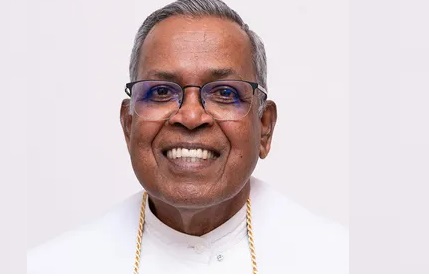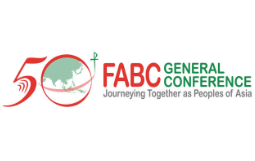Interfaith marriages in our country
Interfaith marriages refer to unions between a Catholic and either a baptized non-Catholic or a non-baptised person. These marriages are often described as “mixed religion” or “disparity of cult.”
Feb 28, 2025

By Fr Joseph Stephen CSsR
Interfaith marriages refer to unions between a Catholic and either a baptized non-Catholic or a non-baptised person. These marriages are often described as “mixed religion” or “disparity of cult.” Parish priests commonly report performing more interfaith marriages than those between two Catholics. As this trend continues to rise, it raises the question: what pastoral responses can the Church offer to these couples? Ideally, priests and couples involved in marriage preparation programmes can explore new and meaningful ways to help prepare these couples for a lasting and harmonious marriage.
Why interfaith marriages? One might be quick to conclude that the Catholic partner who marries either a baptised Christian or a non-baptised person is somehow weak in their own faith. However, such a conclusion would be both simplistic and unreflective.
Many, especially from the older generation, argue that interfaith marriages were unheard of in the past, yet they now seem to be becoming more common. Historically, the Church used harsh language to describe the denominations to which non-Catholic Christians belonged — terms like “heretical” or “schismatic sect” (Canon 1060 of the 1917 Code of Canon Law). While the 1983 Code softened the language toward non-Catholic Christians and non-Christians, it still considers such marriages illicit (Canon 1124).
The teachings of Vatican II emphasised the importance of respecting a person’s conscience and religious liberty, as well as acknowledging the seeds of truth present in other religions. This shift is reflected in the 1983 Code and has contributed to the rise of interfaith marriages in our country.
For many elderly Catholics, however, interfaith marriages remain absolutely forbidden. Their primary concern often centres around the faith of the future children, especially in marriages of disparity of cult. This concern remains a significant factor in the ongoing debate surrounding such unions.
The danger of faith
There is always a potential danger in interfaith marriages. As moral theologian Karl Peschke, who taught in the Philippines and whose two volumes on moral theology were once used as textbooks at College General Penang, noted, “Mixed marriages always present a problem, especially when the non-Catholic partner holds strong religious convictions.”
Mixed marriage and the Eucharist
The Catechism of the Catholic Church teaches that “the Eucharist is the source and summit of Christian life.” If we take this teaching seriously, then the importance of the Eucharist cannot be overlooked, especially for married couples who wish to live out their Christian faith within their families and share it with their children. Vatican II redefined marriage as a “covenant between two persons,” contrasting the pre- Vatican II view, which saw marriage primarily as a “juridical contract.”
In some dioceses, the Catholic partner must seek permission from the bishop in order to receive Holy Communion in a mixed marriage. However, Christians are already in communion with Jesus through Baptism and their relationship with Him, signifying an existing union. So, why does this become a point of contention when it comes to the Eucharist?
What can the local Church do? I believe the Church should approach this topic with greater depth, not only by examining Canon law but also by considering the social realities within our local community. Church leaders should consult theologians who have extensively studied marriage, as well as sociologists and experienced pastoral theologians, to help us understand the issue from multiple perspectives. Each of these experts can offer valuable insights. Too often, I have heard people turn to canon lawyers for answers.
While their contributions are important, they tend to focus primarily on the legal aspects, which may not fully address the complexities of the issue.
After being a priest for 45 years, I believe this topic should not be abandoned once we are ordained. Seminarians spend more years studying to be ordained than many other professionals, and they must delve deeply into the subject of marriage. However, we minister in a changing world, and our understanding must evolve.
Much is said after our ordination. In Familiaris Consortio, Pope John Paul II taught that “with regard to the sharing of the non- Catholic party in Eucharistic Communion, the norm issued by the Secretariat for promoting unity should be followed” (FC 78).
Marriage is a path to Christian perfection: “Those who administer the Sacrament to others are called to care for each other’s spiritual welfare. God comes to each partner, and through the other, they both return to God, becoming a means of grace to one another in every detail of daily life” (V. Tirimanna, A Few Theological and Pastoral Perspectives).
Furthermore, as Karl Rahner long ago pointed out, it is difficult to divide the world, created by God, into the “sacred” and the “non-sacred.” As he wrote, “The Spirit blows where He wills” (Jn 3:8).
This issue becomes even more complicated when we consider the historical fact that marriage was officially recognised as a sacrament only in the thirteenth century (L. Orsy).
Some of us priests view secularism, secularisation, and the secular world as enemies of the Church. This often leads to a tendency to react to these terms, seeing them as inherently anti-Catholic. However, the concept of the secular is actually rooted in the Judeo-Christian tradition. It was Christianity that gave people the power to shape and engage with nature. Jesus did not condemn those who made Jerusalem a secular city; instead, He wept over it.
The Church must learn to work and live within a secular world. We cannot afford to be a right-wing or left-wing Church; we must be a Church for all people.
Perhaps this is a topic we have not fully understood, and one that requires ongoing reflection and learning.
How can people who are involved in marriage preparation help?
While it is true that they carry a significant responsibility in the parish or diocese, the question remains: how much support does the Church provide to help them become effective formators? Are we preparing them to understand the realities couples face today as they prepare for marriage? Do they grasp the theology of marriage, are they familiar with the latest teachings on marriage, the Holy Father’s views on the topic, or the documents from the Council on interreligious dialogue? Have we ever considered inviting a Hindu teacher to contribute to Catholic marriage preparation by offering insight into their understanding of marriage and the meaning of their rituals?
Ultimately, priests strive to offer couples a meaningful and rich celebration of their marriage. We must continually pray for the couples for whom we serve as official witnesses, asking God to guide them in their journey together.
(The views expressed are entirely the writer’s own.)







Total Comments:1